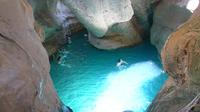Day Trip: Wadi Shab and Bimah Sinkhole
Muscat, Oman
Trip Type: Day Trips
Duration: 8 hours
On this tour visit, Quriyat Village (Fish Market and Fort), Bimah Sinkhole, Trek in Wadi Shab and see the ruins of Bibi Miriams Tomb.
More About This Activity All Day Trips →
On this tour visit, Quriyat Village (Fish Market and Fort), Bimah Sinkhole, Trek in Wadi Shab and see the ruins of Bibi Miriams Tomb.You will be picked up from the hotel for a journey down the coast. First of all you will stop at the fishing village of Qurayat and then proceed to Bimah Sinkhole, a geological feature and a scenic wonder. Further on is the white sandy beach of Mokhalla in Fins. From there it is a short drive to Wadi Shab that can be done as a day hike from Tiwi village. Needless to say, prepare to get very wet! The Wadi Shab hike takes about 2 hours before you hit reach the “end-point”.
Next and last, Visit the ruins of Bibi Miriam’s Tomb at Qalhat. As the only standing remains of the once thriving port city of Qalhat, Bibi Miriam’s Tomb is probably one of the most photographed ancient relics in Oman. Believed to have been built by Bahauddin Ayez, King of Hormuz in honour of his wife, it stands on the hill just outside the village of Qalhat. The rest of the port city, destroyed by the Portu-guese in the early 16th century, is gradually being reconstructed by an international team of archaeologists; if you visit between October and March you’ll be able to see them at work and ask questions first hand.
You will then return to Muscat.
Next and last, Visit the ruins of Bibi Miriam’s Tomb at Qalhat. As the only standing remains of the once thriving port city of Qalhat, Bibi Miriam’s Tomb is probably one of the most photographed ancient relics in Oman. Believed to have been built by Bahauddin Ayez, King of Hormuz in honour of his wife, it stands on the hill just outside the village of Qalhat. The rest of the port city, destroyed by the Portu-guese in the early 16th century, is gradually being reconstructed by an international team of archaeologists; if you visit between October and March you’ll be able to see them at work and ask questions first hand.
You will then return to Muscat.
« Go Back

